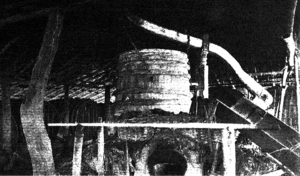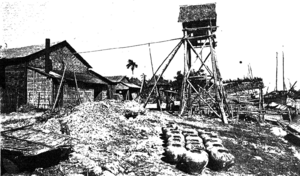Lambanog facts for kids
| Type | Palm liquor |
|---|---|
| Country of origin | Philippines |
| Region of origin | Luzon, Visayas |
| Alcohol by volume | 40–45% |
| Ingredients | Coconut sap |
Lambanóg is a traditional Filipino distilled coconut palm liquor. It is derived from tubâ made from coconut sap that has been aged for at least 48 hours. It originates from Luzon and the Visayas Islands (where it is known as dalisay de coco). During the Spanish colonial period, it was also known as vino de coco in Spanish. It is also commonly described as "coconut vodka" due to its clear to milky white color and high alcohol content. It is particularly potent, having a typical alcohol content of 80 to 90 proof (40 to 45% abv) after a single distillation; this may go as high as 166 proof (83% abv) after the second distillation. Its smoothness has been compared to that of Japanese sake and European schnapps.
A similar distilled drink made from nipa palm sap is known as laksoy.
Description


Lambanóg has a very high alcohol content of 40%-45% abv (80 to 90 proof), in comparison to bahalina (10%-13% abv) and tubâ (2% - 4% abv). Lambanóg is usually served pure, though it can also be traditionally flavored with raisins. Modern lambanóg has recently been marketed in several flavours such as mango, blueberry, pineapple, bubblegum and cinnamon in an effort to appeal to all age groups.
Production

Lambanóg production was traditionally centered in the Southern Tagalog region. The current main producing areas are the provinces of Quezon, Laguna, and Batangas, where coconuts are a dominant agricultural crop. Most lambanóg producers are small-scale cottage industries with only around 4 to 25 employees. Quezon is the leading producer of lambanóg, hosting the three largest lambanóg distillers of the country: Mallari Distillery, Buncayo Distillery, and Capistrano Distillery. Lambanóg (as dalisay or dalisay de coco) were also produced in the Visayas Islands in the Spanish colonial period of the Philippines.
Safety
Unregistered lambanóg production is illegal in the Philippines under regulations by the Food and Drug Administration and the Department of Agriculture. Consumers are warned to only purchase lambanóg that is properly sealed and made by companies registered with the FDA. Several deaths still occur each year from methanol poisoning after drinking lambanóg moonshine or adulterated lambanóg from retailers.
In December 2019, at least 11 people died and in excess of 300 treated after drinking home-brewed lambanog coconut wine in Laguna and Quezon, two provinces south of Manila.

